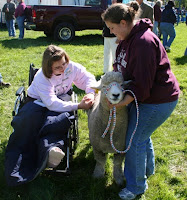
A Texel lamb exhibited by Beverly and Sherman Pearsall from Thurmont, MD, was the champion carcass lamb at the 2007 Maryland Sheep & Wool Festival.
Known for their outstanding carcass qualities, Texel lambs have typically won the carcass contest at this annual Maryland event.
The winning 101 lb. ram lamb had the largest ribeye in the class at 3.17 square inches. His backfat measurement was 0.145 inches, resulting in a yield grade of 1.9 and 50.42 percent of boneless closely trimmed retail cuts (BCTRC).
The Pearsalls also had the lamb with the second highest percent BCTRC at 50.33 percent. It was a 93 lb. Texel, with a 2.69 square inch ribeye. The only other lamb with a ribeye over 2.5 square inches was an 87-lb. Suffolk ewe lamb exhibited by Peter and Kelly Vorac from Jefferson, MD. Its ribeye measurement was 2.61 square inches. It ranked third in %BCTRC.
The lamb with the highest
lean rate-of-gain was a 112-lb. Hampshire exhibited by Tammy Holler from Oakland, MD. Its lean rate-of-gain gain was 0.37 lbs. per day. It won this honor on the strength of its live rate-of-gain: an exceptional 1.43 lbs. per day (from birth).
Ribeye area and backfat thickness were determined using real-time ultrasound. Ultrasound scanning is a way to determine carcass characteristics, without sacrificing the lambs. It is particularly useful for identifying outstanding rams.
This year, the scanning was done by Jim Pritchard, a certified scanner from West Virginia University. Carcass weight, body wall thickness, yield grade, and %BCTRC were determined by calculations, using data from the ultrasound measurements.
Fifteen (15) lambs competed in this year's carcass contest. They represented a diversity of breeds and crosses: Hampshire, Southdown, Suffolk, Texel, and Tunis and Katahdin crosses. Most of the lambs were very young, averaging only 87.4 lbs. Average backfat thickness was only 0.13 inches, resulting in an average yield grade of 1.65, while the average ribeye measurement was 2.10 square inches.
The lamb carcass contest at the Maryland Sheep & Wool Festival is open to any breed or breed cross of lamb, of any sex, weighing at least 80 lbs. It is held on the Saturday of the Festival at 3 p.m.
The
Maryland Sheep & Wool Festival is always held the first full weekend in May and is sponsored by the Maryland Sheep Breeders Association.
 Hanson was chosen to advise on agricultural issues, one of which is to help create a reliable supply of quality hides for use in a leather factory. Hanson would like to organize three farmers associations in Iraq's Kurdish, Shia and Sunni regions to supply the factory with sheep hides.
Hanson was chosen to advise on agricultural issues, one of which is to help create a reliable supply of quality hides for use in a leather factory. Hanson would like to organize three farmers associations in Iraq's Kurdish, Shia and Sunni regions to supply the factory with sheep hides.










